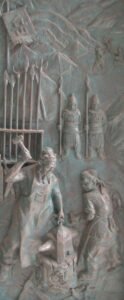“This is truly a hand-made wrought iron door” we often hear these words when buying iron doors, and we meet another word, ” cast iron,” frequently when buying ironware products. Wrought iron and cast iron, which one is better for iron doors?
Wrought iron is better for iron doors. Because it is malleable to be forged, has a smoother surface, and is easier to be galvanized to prevent corrosion from iron doors and gates.
In the following part, you will read
- What is cast iron?
- What is wrought iron?
- Why is wrought iron better than cast iron for iron doors?
- The right place to use cast iron.
- Can we use ductile cast iron in iron doors?
What is cast iron?
Cast iron with a rough surface
Cast iron made from crude iron is called “pig iron” it is always melted and poured into a mold to get a customized shape after cooling down. The carbon content in cast iron varies from 2% to 4%.
What is wrought iron?
Wrought iron is highly refined; a little silicate slag helps forge. We call it “wrought” because the wrought iron can be hammered, forged, or bent into the scrolls as expected when hot enough. Compared with cast iron, the carbon content in wrought iron is very low, about only 0.08%.
Why is wrought iron better than cast iron for iron doors?
Malleable to be forged
Cast iron is brittle and non-malleable because of its higher carbon content (2%~4%) than wrought iron (0.08%). When a blacksmith strikes and bends cast iron, it will fracture. While wrought iron is highly malleable and robust, its strength will be consistently demonstrated when facing immense pressure. After it is heated to work, the wrought iron will become stronger than before. Different metal scrolls need to be bent and hammered in iron doors, especially in those entry doors of a customized design.
Smoother surface for powder coating and painting
Wrought iron will have a smoother surface than cast iron. A smoother surface will make the door look nicer; what’s more, a smoother surface will be easier to be powder-coated and painted, and the painting works quality will affect the iron doors’ beauty.
Easier to be galvanized for anti-corrosion
All irons are easy to be rusty when exposed without any protection. There are 3 ways for iron doors to resist corrosion. Except for the mentioned ways of painting and powder-coated, galvanization, also known as ” hot-dipped-zine,” is a crucial method to resist corrosion for iron doors. Wrought iron will be easy to let the zinc enter into itself and attach to it in galvanizing. Cast iron surface is too rough, and this will waste too much zine and need more work to make it smooth. It will cost too much for cast iron to be galvanized.
The right place to use cast iron
Cast iron is more robust than wrought iron, and harder cast iron can resist deformation under immense pressure. Cast iron is cheaper and more time-saved to produce.
Earlier in the 5th century BC, the Chinese invented cast iron, which was poured into molds to make pots, plowshares, pagodas, and weapons. Nowadays, cast iron applies mainly in industry. We can see outdoor furniture made of cast iron in the park, such as a bench. We can see cast iron anywhere in kitchens, cast iron pans, cast iron griddles, cast iron grills, cast iron ovens, etc.

Can we use ductile cast iron in iron doors?
Ductile iron, known as ductile cast iron, was developed in 1948. It has graphite in the form of concentric layers forming the nodules. The carbon content usually is 3%. It will not break when bent, twisted or deformed because of its unique microstructure. Ductile cast iron applies in precision casting; it is a good material for pipes, fittings, and valves. Sometimes we use a few ductile irons in the iron door and gate because it has a smoother surface than cast iron (cost less for galvanization) and because it looks more beautiful and smooth line.
Conclusion
Cast iron is harder under compression and applies mainly in industries such as outdoor furniture and kitchen cooking utensils. In comparison, wrought iron is stronger under tension and is used in decoration. It can be the primary material for iron doors.

